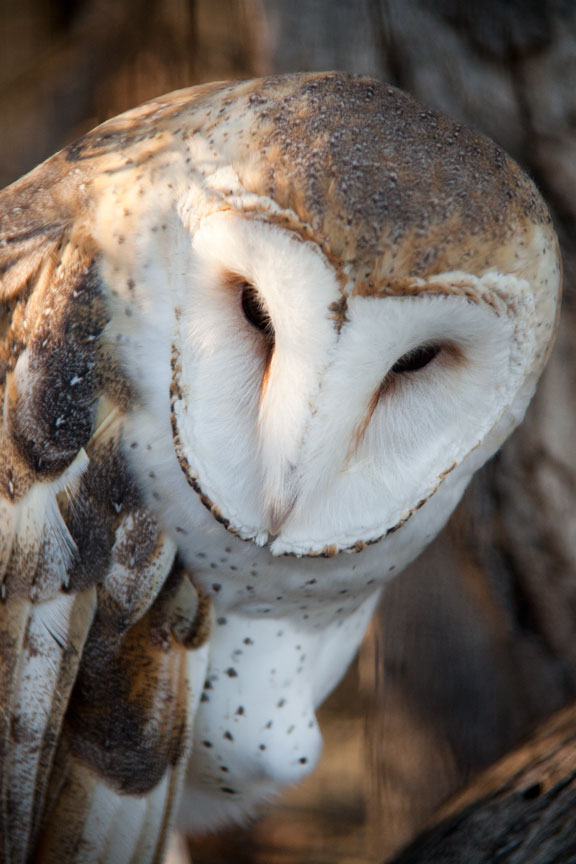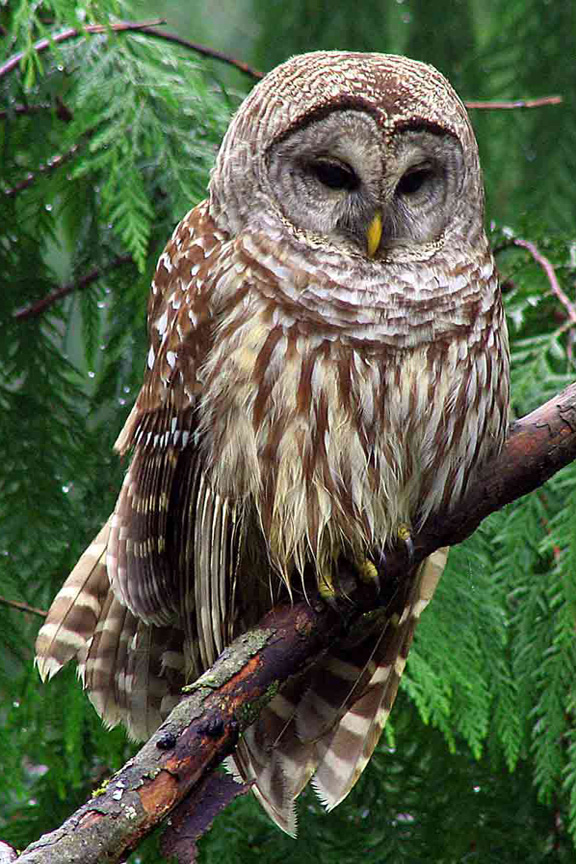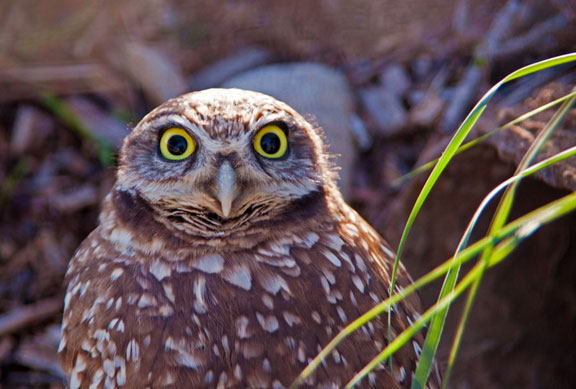
Barn Owl
Maybe it’s their eyes, maybe the shape of their face or the amazingly soft feathers that I find fascinating about owls. Whatever it is I’m grateful we have several that roost in our trees and awaken me at night with their hooting and distinctive calls. Mostly I hear the Barred Owl and sometimes a Spotted Owl. The Great Horned Owl’s deep hoots arouse a peaceful feeling in me, of being one with nature. The coyotes late night serenading give me that same feeling, happiness in knowing that in this bustling, concrete and asphalt world there are still small holdings of forest and old-growth trees where these marvelous birds and animals can live.
Owls can be found in nearly every type of habitat; forests, deserts, open tundra and neighborhoods. The Barn Owl is one of the world’s most widespread birds and prefers to nest in, you guessed it, barns. In cities they may choose ledges, abandoned structures and nesting boxes built by ‘owl lovers’ hoping an owl family will nest in their own backyard. (A note here to my brother Steve and his wife Darla, “Don’t give up, your owl will come!”).

Barred Owl
This Barred Owl frequents our Big Leaf Maple tree on a regular basis in the winter months. The lack of leaves enables easier scanning of our yard for mice, birds and other small critters. I almost always know when it is up in the tree because the bird feeder is void of all birds and squirrels. With the patience of a cat the owl will sit for hours waiting. Sometimes its eyes are closed and I think it might be napping when suddenly he hears something and quietly swishes towards the ground grabbing its prey. Owls have special feathers that allow the wind to pass through making them very quiet in flight. Along with quiet flight their amazing hearing and farsightedness contribute to their efficient hunting, although they can’t see very well close-up.

Burrowing Owl
Some people think owls can turn their heads all the way around, not true, but almost! They can rotate their head 135 degrees in each direction, 270 degrees total. Their eyes are fixed and don’t rotate in the socket like ours. They compensate for this by bobbing their head up and down, side to side to access distance and direction.
Nearly all owls are solitary and monogamous remaining with their mates until one dies. The female sits the nest and the male helps with the feeding of the ‘owlet.’ The female may lay as many as 6-8 eggs but generally only one, sometimes two owlets survive to hatching. Life expectancy depends on the species, 10-15 years is about average with some Great Horned Owls documented to 28 years in the wild.
And apparently I’m not alone in my fascination and love for owls; it seems that owls along with penguins rival for the position of ‘My Favorite Bird.’ After all, didn’t we all want an owl after seeing Harry Potter?
Thanks for reading.
Nancy Cherry Eifert
- Fawn in Ferns
- Gray Squirrel in Cherry Tree
- Young Doe and Woodpile
- Our Little Campground Host
- Luminosity – Peonies
- Peony – A love Affair
- Miller Peninsula State Park – Beach Trail via Fireweed Road
- Iris Duo
- Dosewallip Dance
- Dosewallips River Valley Hike
- Cooper’s hawk in our pond
- Northern Pygmy Owl
- American Pika
- My Photos on Exhibit in the Port Townsend Carnegie Library
- Another successful Wooden Boat Festival
- One of my Photos in 48 North Magazine
- Tulips, Highland Cows and Trumpeter Swans
- Celebrating Spring
- My Owl Buddies
- Celebrating Dia de los Muertos at Seattle Center
- Point Reyes National Seashore
- Brightwork and Bliss
- Ptarmigans and Marmots
- The Olympic Marmot
- Wooden Boat Festival!
- Capitol Campus
- New Show in Gallery Nine for June
- Dosewallips (doh’-si-wall-ips) River Hike
- Sidonie’s Cooking Classes
- Meet Sekiu
- Seattle Aquarium’s Furry Miracle
- Ho! Ho! Ho! Happy Holidays to All!
- Autumn – Cool Days…Cooler Nights
- Alaska & Brown Bears
- Autumn in Alaska
- Crazy gray haired lady arrested for trespassing…almost!
- Bark Shanty Bridge
- Fawn in Ferns
- Gray Squirrel in Cherry Tree
- Young Doe and Woodpile
- Our Little Campground Host
- Luminosity – Peonies
- Peony – A love Affair
- Miller Peninsula State Park – Beach Trail via Fireweed Road
- Iris Duo
- Dosewallip Dance
- Dosewallips River Valley Hike
- Cooper’s hawk in our pond
- Northern Pygmy Owl
- American Pika
- My Photos on Exhibit in the Port Townsend Carnegie Library
- Another successful Wooden Boat Festival
- One of my Photos in 48 North Magazine
- Tulips, Highland Cows and Trumpeter Swans
- Celebrating Spring
- My Owl Buddies
- Celebrating Dia de los Muertos at Seattle Center
- Point Reyes National Seashore
- Brightwork and Bliss
- Ptarmigans and Marmots
- The Olympic Marmot
- Wooden Boat Festival!
- Capitol Campus
- New Show in Gallery Nine for June
- Dosewallips (doh’-si-wall-ips) River Hike
- Sidonie’s Cooking Classes
- Meet Sekiu
- Seattle Aquarium’s Furry Miracle
- Ho! Ho! Ho! Happy Holidays to All!
- Autumn – Cool Days…Cooler Nights
- Alaska & Brown Bears
- Autumn in Alaska
- Crazy gray haired lady arrested for trespassing…almost!
- Bark Shanty Bridge